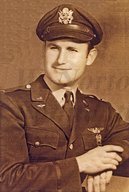
|

|
|
|
|
Claude was born on a farm seven miles from Texarkana, as one of four children of Claude Raymond McCrocklin and Bessie McCrocklin. He grew up listening to stories about his Cherokee-Scotch ancestors, a great-grandfather who fought in the Civil War, and his own father who was an officer in World War I. "So I grew up with a semi military-thinking background," he says. As a boy he hunted squirrels, rabbits, ducks, and turkeys for meat to supplement the table. His family home, he recalls, had no running water or electricity, and was warmed by wood fires. His father farmed cotton, then went to work in the East Texas oil fields in 1934. Young Claude also worked as a roughneck and helped well on the farm. He earned a football scholarship to Centenary College where he was studying geology when America entered World War II. In his junior year he volunteered for duty in the air forces at Barksdale Field. In 1942 he was called up and sent to Santa Ana Army Air Base in California for pre-flight training. Classified as a bombardier cadet, he sent to advanced bombardier training at Deming, New Mexico, in mid-1943. There he learned to use the Norden bombsight, which he calls "the world's first sophisticated computer." He was sent on to Davis-Monthan Air Force Base in Tucson, Arizona, for phase training where he learned to fly in formation. From Mitchel Field in Long Island, New York, he flew as part of a crew aboard a new B-24 to Foggia, Italy in February of 1944, where he became part of the 744th Squadron, 456th Bombardment Group. Claude recalls flying in World War II as "a bloody business." His aviation cadet class of 1943, he recalls, suffered sixty per cent casualties. In the second and third missions, his bombardment group lost 40 per cent of its crews and planes. The life expectancy of an air crewman, he states, was "approximately four to six weeks." In the winter of 1944, he says, the German air force still retained air superiority over targets, because no long-range fighters were yet available to escort the bombers. "Many times we would lose twenty or thirty or forty or fifty B-17s or B-24s on a mission," he recalls. They flew missions daily, "sometimes twice a day." Claude had served on 12 missions when he was shot down on April 2, 1944. "I was not supposed to fly that day because I had a head cold and a fever." He went on the mission over Vienna, Austria, where German fighters attacked the formation. Although his aircraft was hit, the pilot, Richard Terrell of Hot Springs, Arkansas, took it as far as Zagreb, Yugoslavia when six German fighters attacked and killed the back turret gunners. When he parachuted out, he recalls, a German fighter pilot came so close "I could see the whites of his eyes," Claude recalls. "He looked over, banked up, and saluted me," he says. Claude says there was an unspoken agreement among American and German pilot not to shoot them while in parachute drop. German soldiers quickly captured him when he landed. Placed in a stable with captured Yugoslavian communist partisans, he was soon taken out and into a room in officers' quarters. There he met the German pilot who shot him down. "We talked about an hour and he fed me and gave me some wine and cigarettes and stuff and we got along pretty good," Claude says. He was placed back in the stable when SS units came, took out the Yugoslav guerillas and shot them. He was not shot, he says, because German officials had already broadcast that he was a prisoner of war. He was sent on to Stalag Luft I in Barth, Germany. Claude left active duty in September of 1945. "I was psychologically messed up," he says, "and I was about fifty or sixty pounds underweight after the POW camp experience." Preferring a job on the outside, he became a regional head cattle buyer for John Morrell & Company, a major meat packer. He retired in 1981 and became an amateur archeologist, and has published extensively about his excavations. Claude married Marilyn Dixon in January of 1942. They had one child and three grandchildren. |


